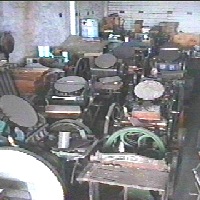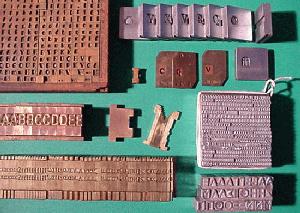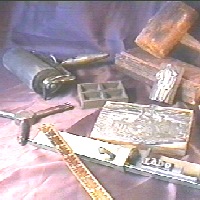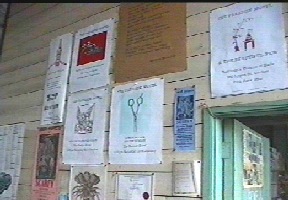VIRTUAL TOUR - COLLECTION: PRESSES, TYPESETTERS, ARTEFACTS,
FOUNTS - PROGRAMS - TYPEFOUNDRY - ACCESS STUDIO
|
Melbourne Museum of Printing |
|
Australia's working and teaching museum of
typography and printing located at Footscray, Victoria. Specialising in
retention of letterpress, both the equipment and the knowledge.
|
 |
 |
 |
 |
 |
 |
| CLICK HERE
for larger images and descriptions of these thumbnails.
|
|
DID YOU KNOW? | (Some key facts about the
Museum) |
| INCLUDING OUR UNWANTED MOVE! |
Virtual Tour Page |
Pardon us as we build this site, for any shortcomings.
For example, many detail files are incomplete, but included to show
the breadth of subject matter we intend to cover. And we will have lots
more illustrations of our machines and artefacts.
We hope you will visit us again soon ! |
|
TOUR THE MUSEUM by browsing this overview, or click one of the
following to navigate by other means:
Return to top
Melbourne Museum of Printing
Virtual Tour
Browse here to find out about our Museum: who we are, what we
have, what we do, how to find us.
Also find what YOU CAN DO at our Museum: use our presses and
types to make your own hand-pulled typographic prints, print your
own book, or investigate how printing was done before the computer.
Our Letterpress Supplies Department known as
Australian Type Company
supports the world-wide use of traditional printing with a
substantial working type-foundry.
Our Museum Shop
has a fascinating range of books, leaflets and samples.
Return to top

Melbourne Museum of Printing
Our Collections
COLLECTIONS DEPARTMENT
Nearly 200 machines and thousands of artefacts.
The Museum has four collections.
Machinery Collection
There are four sections within the Machinery Collection. These are:
- Printing Machines
- Type Machines (letterpress typesetting and typecasting)
- Pre-Press Equipment(more modern processes)
- Other Print-related Machines (e.g. bindery)
Each of these sections is divided into categories.
Founts Collection
There are three sections within the Founts Collection. These are:
- Handset Type Founts
- Typesetting Matrix Founts
- Typecasting Matrix Founts
- PHOTOTYPE/DTP/WP FOUNTS ARE WITH THEIR MACHINERY
Artefacts Collection
The Artefact Collection is divided into many sections, covering
three broad areas. These are:
- Artefacts relating to individual printing jobs. These include
designs, proofs, engravings, stereotypes, made-up type pages,
cutting/creasing formes, quotations, invoices, purchase records and
of course the end product, printed items.
- Artefacts relating to tasks such as hand tools, storage racks
and cabinets, and the myriad materials and items used in printing
which are not machines and not founts.
- Our Libraries. These cover books and papers as artefacts, books about
print and related areas and items printed in our Access Studio.
Ancilliary Collections
These are collections which are not directly related to the printing
industry but to the working environment in general and the office
environment in particular.
They include:
- Office Equipment
- Computers
- Telecommunications
NOTES |
|
A fount [pron font] of type is made up of about 90
different characters (for English: more in many other languages),
and has a number of pieces of type of each character. Text sizes
(such as 8 point) may have a total of 4000 pieces in a fount. Large
display sizes (such as 48 point) may have as few as 200 pieces. |
|
Founts of type are stored in typecases. Typecases are stored in type
cabinets. We have a collection with thousands of founts, hundreds of
cabinets and every kind of accessory and tool used in traditional
printing. |
|
Printing presses are, in the main, either letterpress or offset-
litho. In letterpress there are platen presses and cylinder presses.
They may be motorised or person-powered. They may be hand-fed or
automatically fed. They may be large machines or little desktop
devices. We have them all, dating from about 1850 to the 1980's. |
|
Typesetting for letterpress may be by hand (hand-set type founts) or
by machine. Working machines in our collection include all common
processes: Linotype, Intertype, Ludlow Typograph, Nebitype and
Monotype. And we don't just have one of each: there are about eighty
machines in total. And thousands of founts of matrices for them. |
|
Making hand-set type is the function of a typecasting machine or a
manual type mould, together with sets of matrices. Our typefoundry
has a Trader Horn manual type mould, several Monotype Supercasters
and several Monotype composition casters and a wide range of
matrices. |
|
Our collection also includes many business records and examples of
printing together with artwork, proofs, layouts, negatives, printing
plates, engraved blocks, cutting formes and `rescued' pages and jobs
made up in type. |
|
Our library has a large collection of Books as Artefacts. These
are chosen not for their content but their style and circumstances
of printing and publishing. Also our collection of prints and posters
many of which were printed at the Museum by visitors under our
Access Studio program. |

Our Machinery Collection
Machines of all kinds for printing, typecasting, typesetting,
cutting, folding, camerawork, platemaking, stereo and many others.
For letterpress, offset, foil printing, stampmaking, labelmaking.
|
Our collection of machines features both old technology and new.
After all, what is new today will be old tomorrow. We include quite
a few examples of `new' technology, already outdated after just a
few years. |
|
Technical notes are included with this Department. Historical notes
about the use of any particular machine or process would be found in
our Printing Industry Department.
[BUT DON'T EXPECT TOO MUCH JUST YET, IN THAT AREA.]
|
|
Many machines use sets [or founts] of matrices. These founts are
in our Founts Division (see below), but the description of the mats
and how they work is in this Department. |
Linotype; Intertype; Ludlow; Nebitype; Monotype: machines
which produce metal type, composed ready to print.
Monotype Supercaster, Thompson Typecaster, manual
typecasters: machines which produce single types, for hand
typesetting.
Computer typesetters and other items which produce an
image of type on film or paper; cameras, platemakers, processors:
items which produce or handle images for photo-based printing.
Letterpress platen and cylinder presses and proofers;
Offset presses, photocopiers. Label press. Hot Foil Stamping presses.
Guillotine, folder, stitcher/stapler, jogger, bindery: for
processing the paper before or after printing.
Stereotyping press, melting pot, casting box, backplaner etc.,
for making duplicate printing blocks or rubber stamps.
Stripcasters, to extrude strips of spacing and similar material.
Sundry items. Examples are machines for sawing and mitring
printing types and strip material, machines to make cross-points for
rule-formes, to put security patterns onto typefaces, clean and
adjust mats.

Our Founts Collection
A fount [Spelt as 'font' in US English, and pronounced
'font' in any dialect] is an old typefounder's term for the
quantity of type made in one founding. [OED]
|
In the printing sense, the fount of type was meant to be an
inexhaustible supply of letters (of the one face and size), from
which a book was composed. Each fount is stored in a type case,
a kind of tray with about 90 compartments, or perhaps a pair of cases
to achieve larger compartments. |
|
As the compositor used up the letters, they would be topped up. Work
would stop if the `case' ran out of any letter. |
|
The collection includes many founts of type, new and used, with the
majority ranging up to 60 years old. Some are older, with many
from foundries long since closed. Most are stored in cases, and some
`tied up' on galleys. |
|
For the typefoundry, there are many founts of matrices for making
hand-set type. It is relevant to note that unlike a fount of type,
a fount of typecasting mats has only one of each character. So it
is not a fount in the truest sense. But it was obviously
convenient to use the same term. |
|
For the linecasters (Linotype, Ludlow, etc.) the matrix founts are
stored and used in magazines or matrix cases, and there are plenty
of them. |
|
Founts of matrices are listed here, but their technical notes
will be found along with the machine that uses them. |
Handset Type Section
- Monotype Founts
Produced either by printers with their own Monotype plant or
by typefounders using Monotype, as the majority were in this century.
- Foundry Types
Produced by typefounders using pre-Monotype equipment. These
fouunts tend to be of harder metal and deeper engraving, quality not
obtainable with the Monotype system. Many typefounders had their own
typefaces, made their own matrices and possibly their own
typecasting machinery, and this is reflected in the founts.
- Special Purpose Types
Includes types of brass and other metals for hot stamping
and types on odd-shaped body, as for certain overprinting machines.
- Poster Types
Larger types, from about 72 points [one inch] up to several
inches, and usually of wood.
Typesetting Matrix Section
- Monotype Composition
Mats
Usually from 6pt to 14pt with a few of 5, 18 and 24
point size. Each fount has one matrix of each character.
- Linotype and Intertype
Mats
From 4-3/4 point to 36 point, but the majority from 6
point to 14 point. Mats are stored in magazines. Each fount
has a quantity of mats of each character (up to 21 is possible).
- Ludlow and Nebitype
Founts
From 6 point to 96 point, with a different kind for
120 and 144 point. Mats are stored in matrix cases (similar to type
cases. Each fount has a quantity of mats of each character (there is
no particular limit, but up to 10 is common).
- Cold Typesetting
typefaces.
Including Monophoto, Headliner, Varityper, IBM
Electronic Composer, Compugraphic, Bobst, Singer and Alphatype
systems.
Typecasting Matrix Section

Our Artefact Collection
Look here for items which are not machinery or founts. If you cannot
find what you're looking for, try our
LOOK-UP.
.
|
The Artefact Collection is divided into many sections, covering
three broad areas. |
| Artefacts relating to individual printing jobs. These include
designs, proofs, engravings, stereotypes, made-up type pages,
cutting/creasing formes, quotations, invoices, purchase records and
of course the end product, printed items. |
| Artefacts relating to tasks such as hand tools, storage racks
and cabinets, and the myriad materials and items used in printing
which are not machines and not founts. |
| Our Library and Archives |
Artefacts: engravings, stereotypes, stereo mats, hand tools, cabinetry,
designs, layouts, artworks, negs, plates (offset), printed sheets,
finished works, rubber stamps, etc.
Books: on printing and as examples of printing. Includes thousands
of books assembled to show styles of book design and the work
of hundreds of printers and publishers throughout the world.
Archive of business records (quotes, invoices, working papers).
Thousands of documents giving insight into commerce over the
decades, not only within the printing industry.
Art prints: made in our Access Studio, as well as a few acquired
from other studios.
DESIGN DOCUMENTS
- layouts
- galley proofs
- offset artwork,negatives,plates
- printed examples from range of printing firms
DOCUMENTARY ARTEFACTS
- type formes
- stereotype mats and blocks
- photo-engraved blocks
- cutting / creasing formes
- rubber stamps
HAND TOOLS and OTHER ITEMS
OTHER NON-MACHINERY ITEMS
- display of printer's materials
- composing room tools
- press room items
- print-related furniture
LIBRARY and ARCHIVES
Ancilliary Collections
These are collections which are not directly related to the printing
industry but to the working environment in general and the office
environment in particular.
They include:
- Office Equipment
- Computers
- Telecommunications
Return to top

Melbourne Museum of Printing
Our Programs
PROGRAM DEPARTMENT
Workshops, Courses, Access Studio, Reseearch.
Return to top
Melbourne Museum of Printing

About Us
One of our aims: to preserve not only the hardware of printing
but the skill-base required to use it.
- How to contact us
- Who we are
- What we are
- What we are trying to achieve
- How we got here
- Where is Footscray, Victoria?
Return to top
Melbourne Museum of Printing

Our Type Foundry
One of our aims: . . . to ensure the ongoing availability
of supplies for those who wish to print by letterpress.
Read about AUSTRALIAN TYPE COMPANY, which offers a wide range of
letterpress typefaces and other supplies.
- HAND-SET TYPE, BORDERS, SPACING
- HOT-METAL TYPESETTING BY MAIL
- PRINTING PRESSES - HAND OR AUTOMATIC
All proceeds go to the Museum.
Our MUSEUM SHOP carries a range of visitor packs with
interesting assortments of real letterpress types priced
from $5 to $50 (Australian Dollars). Mail order is possible.
Just give us a call for details.
Return to top
Melbourne Museum of Printing

Our Glossary of Printing
The Museum's Glossary of letterpress terms, many of which have been
incorporated into modern typographic software.
To compare our Glossary with others around the world, we have provided
links to many other great on-line glossaries.
Return to top
Melbourne Museum of Printing

Information about Printing
[NOTE: STILL BEING DEVELOPED]
Origins and development of printing.
Return to top
Melbourne Museum of Printing

Printmaking with Letterpress
Printmaking: use of printing technology for Fine Art
[NOTE: STILL BEING DEVELOPED]
Typographic printmaking : posters, poetry, books, pamphlets produced
with traditional metal typesetting. An established art form in some
countries : hardly recognised in others.
Return to top
Melbourne Museum of Printing

Other Print-related Sites
[NOTE: STILL BEING DEVELOPED]
Links to Australian and world-wide museums, colleges, organisations,
studios and magazines that deal with printing generally and letterpress
in particular.
OUR LINKS TO OTHER GLOSSARIES OF PRINTING ARE HERE and are now working.
Return to top
Melbourne Museum of Printing

VicNet and Victoria
VicNet: Service Provider to the community of Victoria.
Fascinating!
Where in the world is Victoria, Australia?
And where is Footscray, Victoria?
Visit hundreds of sites in this fast-moving State.
Links to everywhere!
Return to top























